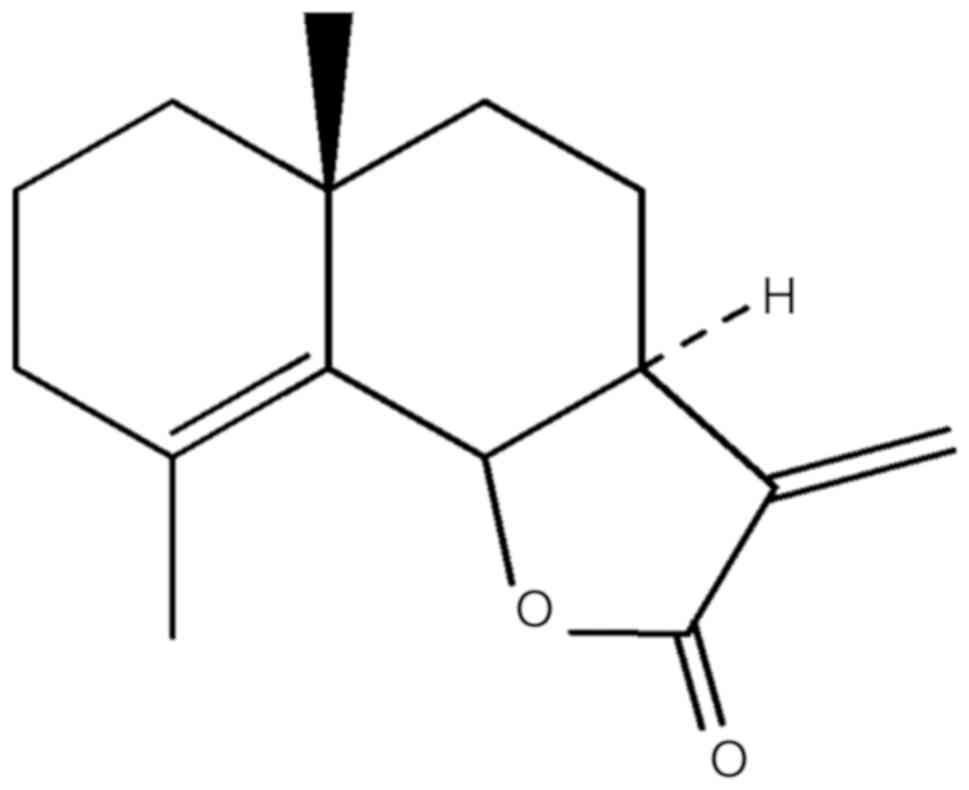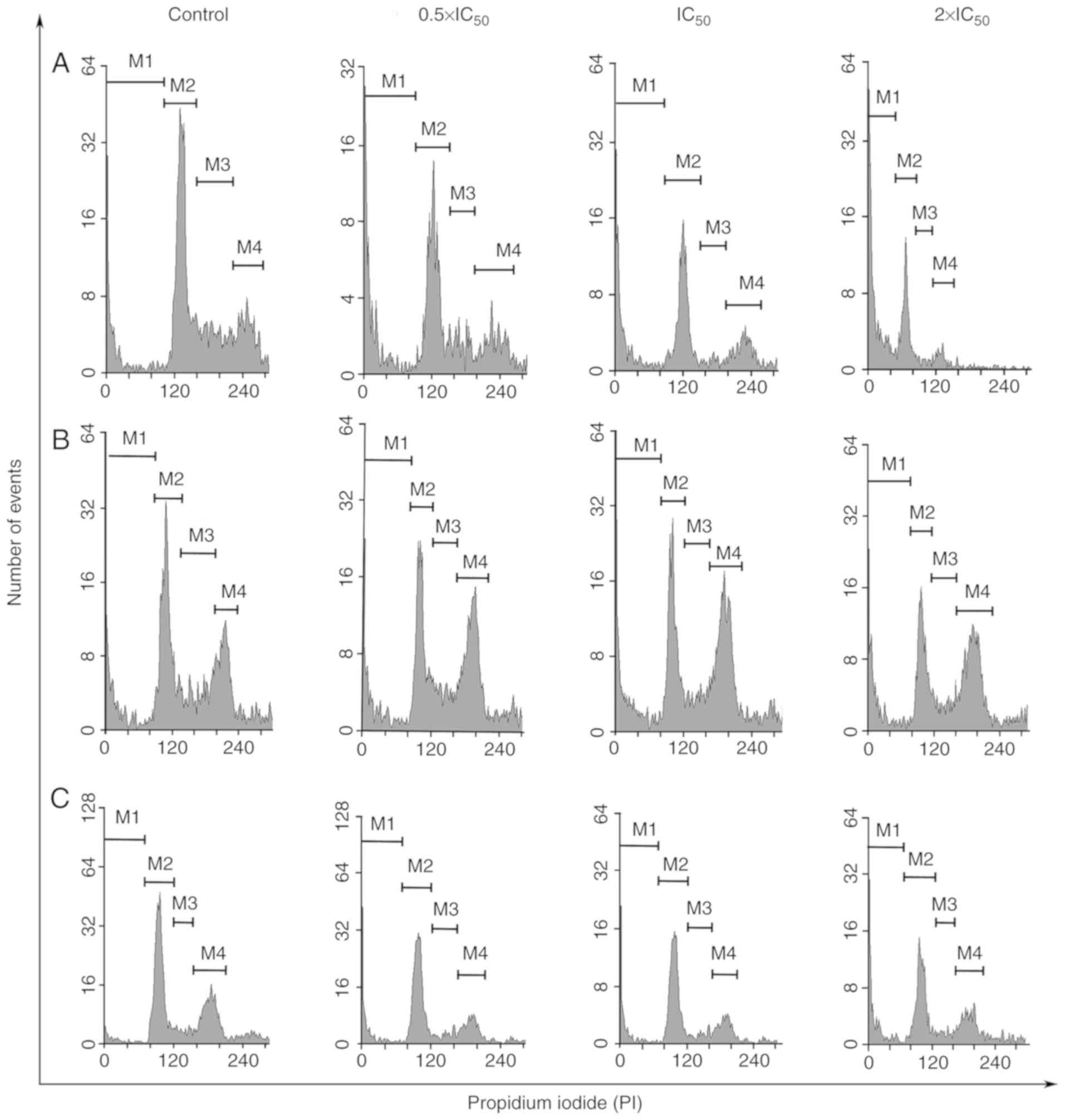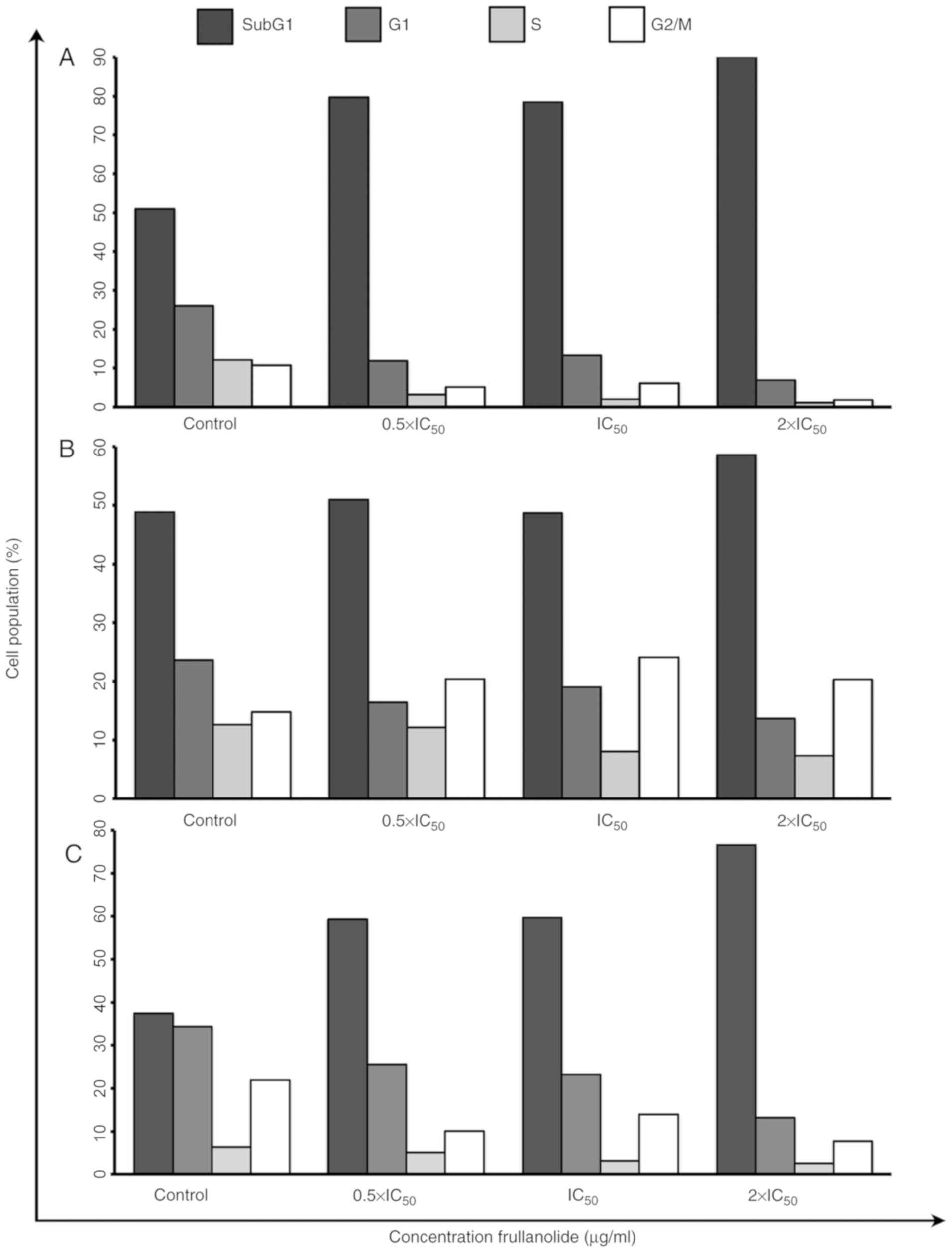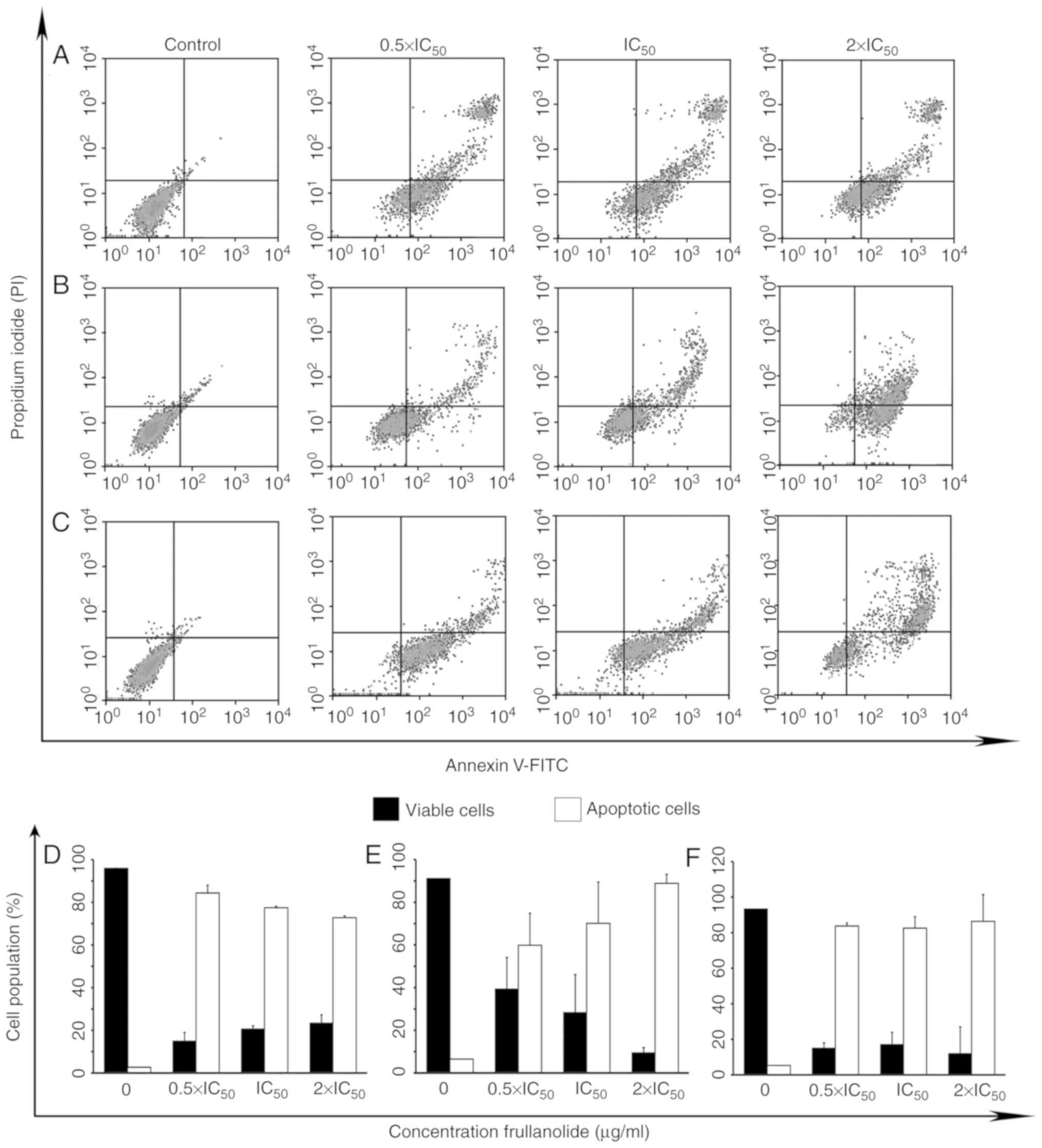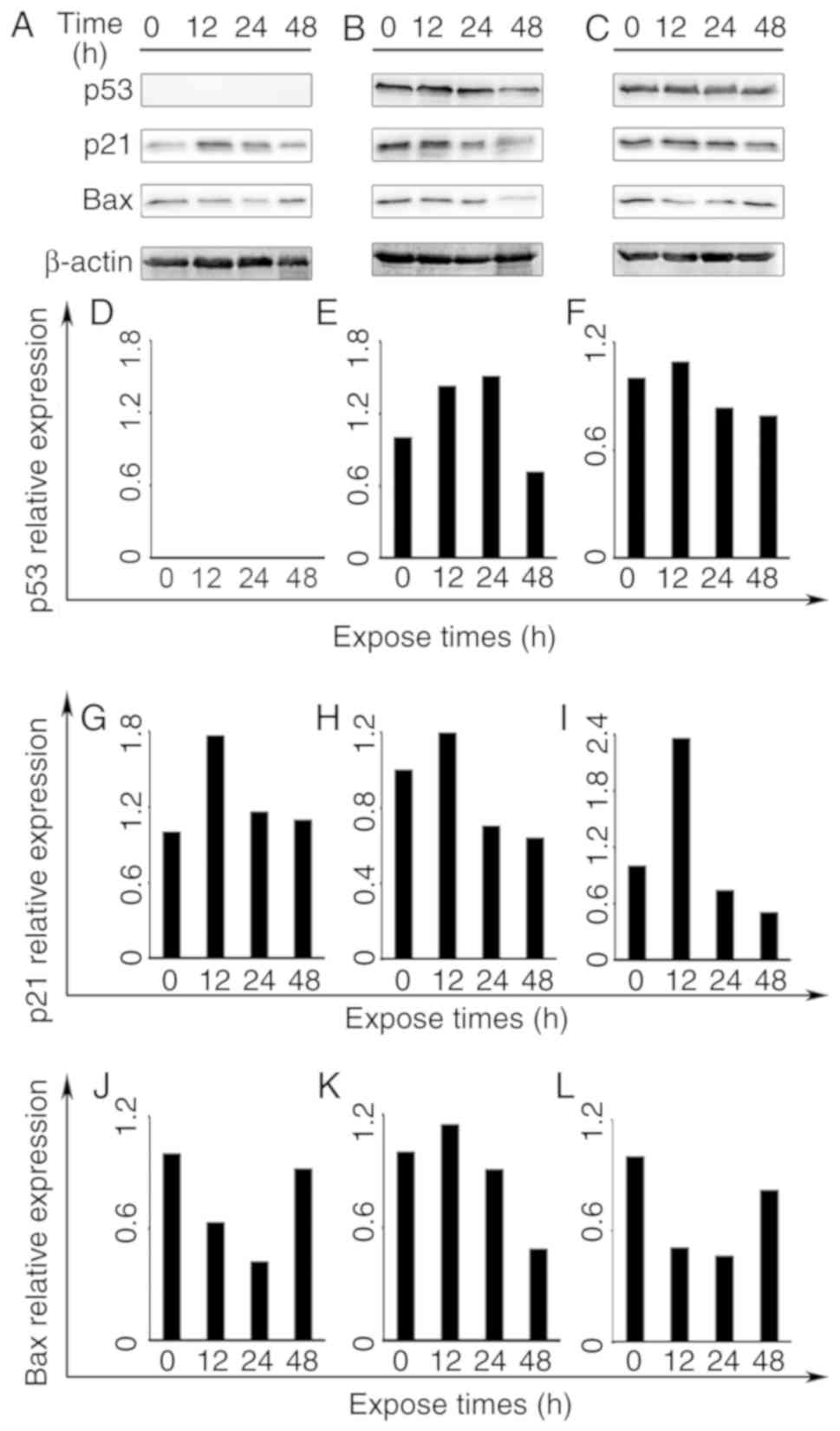|
1
|
Stewart BW and Wild CP: World cancer
Report 2014 Lyon. International Agency for Research on Cancer
(IARC). pp16–53. 2014.
|
|
2
|
Srisawat T, Sukpondma Y, Chimplee S,
Kanokwiroon K, Tedasen A and Graidist P: Extracts from vatica
diospyroides type SS fruit show low dose activity against
MDA-MB-468 breast cancer cell line via apoptotic action. Biomed Res
Int. 2014:4796022014. View Article : Google Scholar : PubMed/NCBI
|
|
3
|
Noble RL: The discovery of the vinca
alkaloids-chemotherapeutic agents against cancer. Biochem Cell Bio.
68:1344–1351. 1990. View
Article : Google Scholar
|
|
4
|
Kumar A, Patil D, Rajamohanan PR and Ahmad
A: Isolation, purification and characterization of vinblastine and
vincristine from endophytic fungus Fusarium oxysporum
isolated from Catharanthus roseus. PLoS One. 8:e718052013.
View Article : Google Scholar : PubMed/NCBI
|
|
5
|
Patel V, Shukla S and Patel S: Free
radical scavenging activity of Grangea maderaspatana Poir.
Pharmacogn Mag. 5:381–387. 2009. View Article : Google Scholar
|
|
6
|
Rao VM, Damu GLV, Sudhakar D and Rao CV:
Two new bio-active flavones from Grangea maderaspatana
(Artemisia maderaspatana). Asian J Chem. 21:1552–1558.
2009.
|
|
7
|
Chaturvedi D: Sesquiterpene lactones:
Structural diversity and their biological activities. In: Tiwari VK
and Mishra BB (eds.): Opportunity, Challenge and Scope of Natural
Products in Medicinal Chemistry. Research Signpost. (Kerala,
India). 313–334. 2011.
|
|
8
|
Ahmed M, Islam MM, Hossain CF and Khan OF:
A preliminary study on the analgesic activity of Grangea
maderaspatana. Fitoterapia. 72:553–554. 2011. View Article : Google Scholar
|
|
9
|
Ruangrungsi N, Kasiwong S and
Likhitwitayawuid K: Constituents of Grangea maderaspatana a
new Eudesmanolide. J Nat Prod. 52:130–134. 1989. View Article : Google Scholar
|
|
10
|
Sangmalee S, Laorpaksa A and Sukrong S: A
topoisomerase II poison screen of ethnomedicinal Thai plants using
a yeast cell-based assay. J Ethnopharmacol. 142:432–437. 2012.
View Article : Google Scholar : PubMed/NCBI
|
|
11
|
Singh D, Mathela CS, Pande V and Panwar A:
Antioxidant and antimicrobial activity of Grangea
maderaspatana (L.) Poir. Extract. JDDT. 1:46–52. 2013.
|
|
12
|
Uppatanpreecha P: Topoisomerase I
inhibitory activity from Thai medicinal plants in yeast cell-based
assay. Dissertation. (Bangkok, Chulalongkorn University). 2009.
|
|
13
|
Ghantous A, Gali-Muhtasib H, Vuorela H,
Saliba NA and Darwiche N: What made sesquiterpene lactones reach
cancer clinical trials? Drug Discov Today. 15:668–678. 2010.
View Article : Google Scholar : PubMed/NCBI
|
|
14
|
Srisawat T, Chumkaew P, Heed-Chim W,
Sukpondma Y and Kanokwiroon K: Phytochemical screening and
cytotoxicity of crude extracts of Vatica diospyroides
Symington type LS. Trop J Pharm Res. 12:71–76. 2013.
|
|
15
|
Alitheen NB, Mashitoh AR, Yeap SK,
Shuhaimi M, Manaf AA and Nordin L: Cytotoxic effect of
damnacanthal, nordamnacanthal, zerumbone and betulinic acid
isolated from Malaysian plant sources. Int Food Res J. 17:711–719.
2010.
|
|
16
|
Wibowo A, Ahmat N, Hamzah AS, Sufian AS,
Ismail NH, Ahmad R, Jaafar FM and Takayama H: Malaysianol A, a new
trimer resveratrol oligomer from the stem bark of Dryobalanops
aromatica. Fitoterapia. 82:676–681. 2011. View Article : Google Scholar : PubMed/NCBI
|
|
17
|
Bézivin C, Tomasi S, Lohézic-Le
Dévéhat F and Boustie J: Cytotoxic activity of some lichen
extracts on murine and human cancer cell lines. Phytomedicine.
10:499–503. 2003. View Article : Google Scholar : PubMed/NCBI
|
|
18
|
Chadwick M, Trewin H, Gawthrop F and
Wagstaff CF: Sesquiterpenoid lactones: Benefits to plants and
people. Int J Mol Sci. 14:12780–12805. 2013. View Article : Google Scholar : PubMed/NCBI
|
|
19
|
Kreuger MR, Grootjans S, Biavatti MW,
Vandenabeele P and D'Herde K: Sesquiterpene lactones as drugs with
multiple targets in cancer treatment: Focus on parthenolide.
Anticancer Drugs. 23:883–896. 2012.PubMed/NCBI
|
|
20
|
Matejić J, Šarac Z and Ranđelović V:
Pharmacological activity of sesquiterpene lactones. Biotechnol
Biotechnol Equip. 24 (Suppl 1):S95–S100. 2010. View Article : Google Scholar
|
|
21
|
Cordell GA, Kinghorn D and Pezzuto JM:
Separation, structure elucidation, and bioassay of cytotoxic
natural products. Colegate SM and Molyneux RJ: Bioactive natural
products, Boca raton, CRC press. 195–216. 1993.
|
|
22
|
Wu C, Chen F, Rushing JW, Wang X, Kim HJ,
Huang G, Haley-Zitlin V and He G: Antiproliferative activities of
parthenolide and golden feverfew extract against three human cancer
cell lines. J Med Food. 9:55–61. 2006. View Article : Google Scholar : PubMed/NCBI
|
|
23
|
van Haaften C, Duke CC, Weerheim AM, Smit
NP, van Haard PM, Darroudi F and Trimbos BJ: Potent cytotoxic
effects of Calomeria amaranthoides on ovarian cancers. J Exp
Clin Cancer Res. 30:1–6. 2011. View Article : Google Scholar : PubMed/NCBI
|
|
24
|
Fischedick JT, Pesic M, Podolski-Renic A,
Bankovicc J, de Vosd RCH, Perić M, Todorovićg S and Tanicc N:
Cytotoxic activity of sesquiterpene lactones from Inula
britannica on human cancer cell lines. Phytochem Lett.
6:246–252. 2012. View Article : Google Scholar
|
|
25
|
Kabeer FA, Sreedevi GB, Nair MS,
Rajalekshmi DS, Gopalakrishnan LP, Kunjuraman S and Prathapan R:
Antineoplastic effects of deoxyelephantopin, a sesquiterpene
lactone from Elephantopus scaber, on lung adenocarcinoma
(A549) cells. J Integr Med. 11:269–277. 2013. View Article : Google Scholar : PubMed/NCBI
|
|
26
|
Costantino VV, Mansilla SF, Speroni J,
Amaya C, Cuello-Carrión D, Ciocca DR, Priestap HA, Barbieri MA,
Gottifredi V and Lopez LA: The sesquiterpene lactone
dehydroleucodine triggers senescence and apoptosis in association
with accumulation of DNA damage markers. PLoS One. 8:e531682013.
View Article : Google Scholar : PubMed/NCBI
|
|
27
|
Maldonado EM, Svensson D, Oredsson SM and
Sterner O: Cytotoxic sesquiterpene lactones from Kauna
lasiophthalma Griseb. Sci Pharm. 82:147–160. 2014. View Article : Google Scholar : PubMed/NCBI
|
|
28
|
Babaeia G, Aliarab A, Abroon S, Rasmi Y
and Gholizadeh-Ghaleh Aziz S: Application of sesquiterpene lactone:
A new promising way for cancer therapy based on anticancer
activity. Biomed Pharmacother. 106:239–246. 2018. View Article : Google Scholar : PubMed/NCBI
|
|
29
|
Ma G, Chong L, Li Z, Cheung AH and
Tattersall MH: Anticancer activities of sesquiterpene lactones from
Cyathocline purpurea in vitro. Cancer Chemother Pharmacol.
64:143-152. 2009. View Article : Google Scholar : PubMed/NCBI
|
|
30
|
Li Y, Ni ZY, Zhuc MC, Dong M, Wang SW, Shi
QW, Zhang ML, Wang YF, Huo CH, Kiyota H and Cong B: Antitumour
activities of sesquiterpene lactones from Inula helenium and
Inula japonica. Z Naturforsch C. 67:375–380. 2012.
View Article : Google Scholar : PubMed/NCBI
|
|
31
|
Mahmoud AA, AlFredan MA and El-Sayed WM:
Isolation, characterization and anticancer activity of seven
compounds from the aerial parts of Conyza triloba. Int J
Pharmacognosy and Phytochem Res. 8:2071–2079. 2016.
|
|
32
|
Rosselli S, Bruno M, Raimondo FM, Spadaro
V, Varol M, Koparal AT and Maggio A: Cytotoxic effect of
eudesmanolides isolated from flowers of Tanacetum vulgare ssp.
Siculum. Molecules. 17:8186–8195. 2012. View Article : Google Scholar : PubMed/NCBI
|
|
33
|
Rivero A, Quintana J, Eiroa JL, Lo´pez M,
Triana J, Bermejo J and Este´vez F: Potent induction of apoptosis
by germacranolide sesquiterpene lactones on human myeloid leukemia
cells. Eur J Pharmacol. 482:77–84. 2003. View Article : Google Scholar : PubMed/NCBI
|
|
34
|
Wang Y, Wang Y, Wu AA, Zhang L, Hu Z,
Huang H, Xu Q and Deng X: New 12,8-eudesmanolides from Eutypella
sp. 1–15. J Antibiot (Tokyo). 70:1029–1032. 2017. View Article : Google Scholar : PubMed/NCBI
|
|
35
|
Holliday DL and Speirs V: Choosing the
right cell line for breast cancer research. Breast Cancer Res.
13:2152011. View Article : Google Scholar : PubMed/NCBI
|
|
36
|
Hudisa CA and Gianni L: Triple-negative
breast cancer: An unmet medical need. Oncologist. 16 (Suppl
1):S1–S11. 2011. View Article : Google Scholar
|
|
37
|
Kandula M, Ch KK and Ys AR: Molecular
mechanism and targeted therapy options of triple-negative (ER, PgR,
HER−2/neu) breast cancer: Review. World J Oncol.
4:137–141. 2013.PubMed/NCBI
|
|
38
|
Sawatdichaikul O, Hannongbua S, Sangma C,
Wolschann P and Choowongkomon K: In silico screening of
epidermal growth factor receptor (EGFR) in the tyrosine kinase
domain through a medicinal plant compound database. J Mol Model.
18:1241–1254. 2012. View Article : Google Scholar : PubMed/NCBI
|
|
39
|
Qin JJ, Wang W, Voruganti S, Wang H, Zhang
WD and Zhang R: Identification of a new class of natural product
MDM2 inhibitor: In vitro and in vivo anti-breast
cancer activities and target validation. Oncotarget. 6:2623–2640.
2015. View Article : Google Scholar : PubMed/NCBI
|
|
40
|
Niculescu III AB, Chen X, Smeets M, Hengst
L, Prives C and Reed SI: Effects of p21Cip1/Waf1 at both
the G1/S and the G2/M cell cycle transitions:
pRb ss a critical determinant in blocking DNA replication and in
preventing endoreduplication. Mol Cell Biol. 18:629–643. 1998.
View Article : Google Scholar : PubMed/NCBI
|
|
41
|
Gartel ALand Tyner AL: The role of the
cyclin-dependent kinase inhibitor p21 in apoptosis. Mol Cancer
Ther. 8:639–649. 2002.
|
|
42
|
Moll UM and Petrenko O: The MDM2-p53
interaction. Mol Cancer Res. 1:1001–1008. 2003.PubMed/NCBI
|
|
43
|
Tsvetkov P, Reuven N and Shaul Y:
Ubiquitin-independent p53 proteasomal degradation. Cell Death
Differ. 17:103–108. 2010. View Article : Google Scholar : PubMed/NCBI
|















